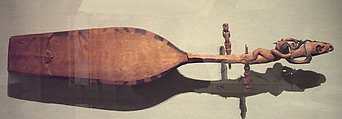Sapeh
Not on view
Muscians in the Kenyah-Kayan region of north-central Borneo play the sapeh, a distinctive plucked lute whose body is open at the back. Sapeh are usually made in pairs with both instruments ideally being fashioned from the trunk of the same tree. The instruments are typically strung with three or four wire strings, the lowermost of which is used to play the melody while the strings above it provide a drone-like accompaniment. The sapeh is most often used to accompany dances such as the musuh (a stylized fighting dance performed by two men with swords and shields), the ngajat (a solo war dance performed by a man or a woman), and several types of line dances. However, it can also be played purely for entertainment.
Most sapeh are relatively plain but, at times, artists create ornate examples that are elaborately carved or painted. On this sapeh the end of the stem is carved in the form of the head of an aso, a fantastic creature combining aspects of dragons and dogs that appears widely in Kenyah-Kayan art where it serves, in part, as a supernatural protector. The tuning pegs are adorned with small human, or human-like, figures, which may also have served a protective function.
Due to rights restrictions, this image cannot be enlarged, viewed at full screen, or downloaded.

